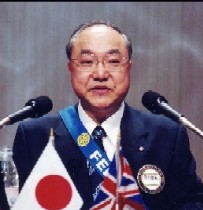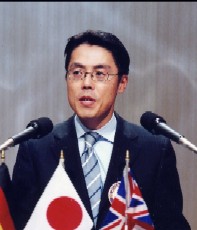Initiation Speech
June 16th,2004
President of Ozax Ltd.
Mr.Toshihiro Ozaki
President of the Nippon Kodoh Co. Ltd.
Mr.Masayoshi Konaka
 President of Ozax Ltd.
President of Ozax Ltd.
Mr.Toshihiro Ozaki��
My classification is Paper Distribution and we have been in this business since my grandfather started it in 1911, some 93 years ago.
When I was a child, I dreamt of belonging to a trading firm, so after graduating my university I joined the Mitsubishi Trading Co., where I worked for seven years in the Machinery Export Headquarters after which I joined Ozax Whose main business is paper distribution and selling material to restaurants.
I wish to tell you two things about my business today. The first is that I am happy I chose this profession as the greatest issue of the 21st century is that of environment.
I am proud of being a member of the paper and pulp industry which is a recycling industry, and I am doing what little I can in this direction.
Secondly, I believe that regarding the issue we face, the production of paper and pulp has in mid- and long term a bright future. The reason is due to not only a recycling industry, but for 3 reasons:
1.��The need for paper in mid- and long term cases, will rapidly grow, especially in Asia.
2.��Japanese paper makers are on the cutting edge of paper making technology, and enjoy a lead in international competition
3.��The base of our industry is firmly established due to large scale mergers and reorganization
On the other hand, the same cannot be said for ourselves in the distribution business. We must be able to keep up with the technological innovation shown by the paper makers, and also be able to innovate our functions.
Thus, if we are able to function as specialized trading house for paper we will be able to establish our reason for being.
We have as our model, the great trading house. They manifest their flexibility to change, and whereas their profits in the past were derived from commissions, their new business model is to gain by investing.
Although it is impossible for us to copy the strategy of major firms, we can change our functions, and we have found much to learn from the restaurant chains such as Skylark and McDonalds. Today, we supply them with not only paper towels, but some 3,500 items for use.
We receive orders, get together the shipment and deliver it, but also from time to time furnish them ideas for better service. Thus we can offer total service as a ��one stop distributor��.
Thus we supply paper for their catalogs and functioning as a ��one stop distributor�� promote business from the supply side, while practicing business in a customer oriented manner.
 President of the Nippon Kodoh Co. Ltd.
President of the Nippon Kodoh Co. Ltd.
Mr.Masayoshi Konaka
Entering the 21st century, I feel that the charms of scents are being rediscovered. The sense of smell is said to be not as highly developed as that of taste, touch, sight and hearing, and perhaps ancient man was able to exercise his sense of smell in a better way.
Recently, the term aromatherapy has become popular by combining aroma with relaxation. A similar phenomenon has arisen in Asia and the West. In this digital world people are longing for a balance of the mind and want to touch on analogue matters.
This is a pursuit of healing, relaxation and well-being, which is not only sufficiency in material matters but also of the mind. The history of scents is a long one and can be traced back to India in the 4th millennium B.C.
This was carried East, and aromatic wood became the material for a mix of their powder and thus gibing birth to incense culture.
Aromas were carried to Egypt and then to Rome, and used in religious rituals by the Christina Church. Coming to Europe it developed the perfume culture of France. Today, a world wide contest of perfume makers is held in Grasse in southern France.
In Japan, incense came to Japan with the arrival of the Buddhist religion and spread. In our ancient annals, the record states that in 595 A.D. an aromatic wood was washed up on the beach in Awaji Island and delivered to the Imperial Court. In those days, aromatic materials were said to deliver your prayers. To cleanse the body it was powdered and spread on the hands, neck and face, and also burnt at funeral rites.
In the Heian Era (794 – 1192 A.D.) the Japanese created an indigenous scent culture, using incense not only for religious rites allowing the pleasant scent to permeate their living quarters, and also their hair and clothing. This practice is well described in the classics ��Tales of Genji��.
In the Kamakura Era (1192 – 1333 A.D.) departing from the refined and sophisticated tastes of the court, the warriors enjoyed the scents of the various wood material themselves. Then, in the Muromachi Era (1381 – 1601 A.D.) many of our indigenous arts were born such as the tea ceremony, flower arranging, noh, and kohdo which combined the enjoyment of scents with literature. Japan closed its doors from the Tokugawa Era (1601 – 1867) where a wealthy merchant class emerged popularizing Kohdo.
When Japan opened its closed doors in 1867 the nation��s aim was to build a strong modern country, and ensued. People pursued material wealth more then spiritual well being which resulted in such arts going underground.
Reflecting on history, only the Japanese starting 1200 years ago were able to enjoy scents in a systematic manner, and refine this into an art form 500 years in the past. We must note the sensitivity the Japanese of that age possessed.
In this age, when we do not any longer take progress for granted, we must reassess our values and rediscover the culture of scents.